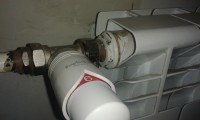Zbigniew Rusek wrote: This is not an easy matter. The shut-off valve must be turned off (flow and return !!!). Unscrew the radiator cap (check the thread direction - it used to be so - in cast iron - that the blind plugs were left, the plugs from the power supply side - right), clean the plug collar thoroughly from rubbish and rust (it must be smooth and clean), clean the collar heater. Replace the gasket with a new one (obligatory) and additionally lubricate it with some sealant (e.g. liquid seal - type of silicone). Tighten firmly (but do not break the thread, because it is an aluminum radiator and not a cast iron radiator). Next, clean the thread on the nipple, screw the valve, apply thread paste, tow and paste on the tow again and screw this nipple into the radiator cap (exactly, to the end). Only then tighten the valve nut. Attention. Clean the cone of dirt well. It cannot be upholstered (therefore it cannot be thrown onto a concrete floor or hit with steel or cast iron objects), because it is sealed only "cut", i.e. one part is fitted (lapped, polished) to the other and when the cone is damaged, tight tightening is almost impossible (there is no seal).
Looking at the leak, I dare say that the plug was not tightened tightly, and when screwing the screw connection it became loose and the installer did not notice it. Fachman will do it in 30-60 min as the book writes.
This leak can be quickly removed in 5 minutes, more time will go down the stairs to the apartment

.
Edit: A colleague wants to remove it the cheapest, as I wrote above, there is nothing to exaggerate the problem.






